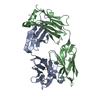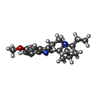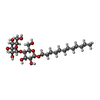+Search query
-Structure paper
| Title | Serotonin transporter-ibogaine complexes illuminate mechanisms of inhibition and transport. |
|---|---|
| Journal, issue, pages | Nature, Vol. 569, Issue 7754, Page 141-145, Year 2019 |
| Publish date | Apr 24, 2019 |
 Authors Authors | Jonathan A Coleman / Dongxue Yang / Zhiyu Zhao / Po-Chao Wen / Craig Yoshioka / Emad Tajkhorshid / Eric Gouaux /  |
| PubMed Abstract | The serotonin transporter (SERT) regulates neurotransmitter homeostasis through the sodium- and chloride-dependent recycling of serotonin into presynaptic neurons. Major depression and anxiety ...The serotonin transporter (SERT) regulates neurotransmitter homeostasis through the sodium- and chloride-dependent recycling of serotonin into presynaptic neurons. Major depression and anxiety disorders are treated using selective serotonin reuptake inhibitors-small molecules that competitively block substrate binding and thereby prolong neurotransmitter action. The dopamine and noradrenaline transporters, together with SERT, are members of the neurotransmitter sodium symporter (NSS) family. The transport activities of NSSs can be inhibited or modulated by cocaine and amphetamines, and genetic variants of NSSs are associated with several neuropsychiatric disorders including attention deficit hyperactivity disorder, autism and bipolar disorder. Studies of bacterial NSS homologues-including LeuT-have shown how their transmembrane helices (TMs) undergo conformational changes during the transport cycle, exposing a central binding site to either side of the membrane. However, the conformational changes associated with transport in NSSs remain unknown. To elucidate structure-based mechanisms for transport in SERT we investigated its complexes with ibogaine, a hallucinogenic natural product with psychoactive and anti-addictive properties. Notably, ibogaine is a non-competitive inhibitor of transport but displays competitive binding towards selective serotonin reuptake inhibitors. Here we report cryo-electron microscopy structures of SERT-ibogaine complexes captured in outward-open, occluded and inward-open conformations. Ibogaine binds to the central binding site, and closure of the extracellular gate largely involves movements of TMs 1b and 6a. Opening of the intracellular gate involves a hinge-like movement of TM1a and the partial unwinding of TM5, which together create a permeation pathway that enables substrate and ion diffusion to the cytoplasm. These structures define the structural rearrangements that occur from the outward-open to inward-open conformations, and provide insight into the mechanism of neurotransmitter transport and ibogaine inhibition. |
 External links External links |  Nature / Nature /  PubMed:31019304 / PubMed:31019304 /  PubMed Central PubMed Central |
| Methods | EM (single particle) / X-ray diffraction |
| Resolution | 2.3 - 4.8 Å |
| Structure data |  EMDB-0437: EMDB-8940, PDB-6dzv: EMDB-8941, PDB-6dzw: EMDB-8942, PDB-6dzy: EMDB-8943, PDB-6dzz:  PDB-6d9g: |
| Chemicals |  ChemComp-HOH:  ChemComp-HJM:  ChemComp-Y01:  ChemComp-8PR:  ChemComp-NAG:  ChemComp-LMT: |
| Source |
|
 Keywords Keywords | IMMUNE SYSTEM / Antibody / TRANSPORT PROTEIN/IMMUNE SYSTEM / ibogaine / human serotonin transporter / Fab / TRANSPORT PROTEIN-IMMUNE SYSTEM complex / paroxetine / antidepressant |
 Movie
Movie Controller
Controller Structure viewers
Structure viewers About Yorodumi Papers
About Yorodumi Papers











 homo sapiens (human)
homo sapiens (human)
